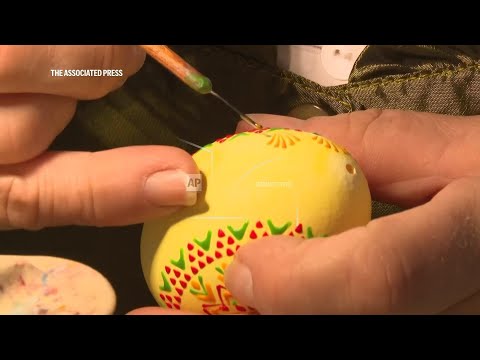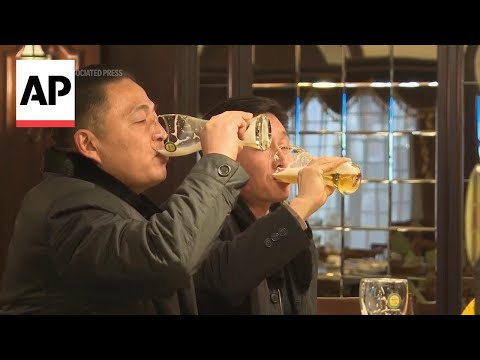(14 Apr 2025)
RESTRICTION SUMMARY:
ASSOCIATED PRESS
Schleife, Germany -10 April 2025
1. Pull focus from crocheted chick to egg being painted
2. Close of egg being painted
3. Woman decorating egg with wax
4. Pull focus from decorated eggs to woman painting egg
5. Decorated Sorbian Easter eggs on sale
6. SOUNDBITE (English) Stephanie Bierholdt, employee at the Sorbian cultural center in Schleife: ++STARTS ON SHOT 1 AND PARTIALLY OVERLAID BY SHOTS 7 AND 8++
“Today we have our Easter market, it’s the 26th edition already. We are celebrating Easter with decorating Easter Eggs in different kinds of styles. And we have more than 30 people here who are decorating the Easter eggs. The Sorbian people come from the former Yugoslavia and nowadays we have the Sorbian people here as a minority. So, it’s one of the four minorities in Germany. We have about 40,000 to 60,000 Sorbian people here in Germany.”
7. Women in traditional Sorbian clothing decorating eggs
8. Close of wax being applied to egg
9. SOUNDBITE (German) Anke Hanusch, Sorbian egg decorator: ++PARTIALLY OVERLAID BY SHOTS 10 TO 18++
“The honeycomb stands for diligence. The godparents use the eggs to wish their godchildren a happy Easter. We have the sun here, which simply means radiant happiness, rising, warmth, light and growth. We have the ears of corn, which stand for food and prosperity. Wolfszaehne, that’s the triangle we always use, arranged as a circle, protects the building, the yard and is supposed to protect against wild animals. As soon as you can hold a pen, you can also hold a goose feather quill or a needle. Then you can start making tally marks and the children do this at the age of two or three. I think it’s a valuable cultural asset that needs to be preserved. It would be a shame if it died out.”
10. Wax being applied on egg
11. Various of egg with sun symbol, ears of corn symbol and wolfs teeth
12. Close of egg with symbols of wolf teeth elements
13. Wide of different decorated Sorbian Easter eggs
14. Basket full of decorated Sorbian Easter eggs
15. Woman buying decorated Sorbian Easter egg
16. Decorated Easter eggs in basket
17. Decorated Easter eggs on display
18. Close of Easter bunny smiling
STORYLINE:
Anke Hanusch dips her needle into dark blue wax and dots it precisely on a yellow-dyed Easter egg in her hand.
Back and forth, wax to egg, egg to wax, as the honeycomb pattern grows.
The intricate motif means the egg will ultimately be a gift from a godparent to their godchild, to bestow diligence and a good work ethic upon the youngster.
The tradition of decorating Easter eggs is part of the culture of the Slavic-speaking Sorbian ethnic minority in Germany.
Modern-day Sorbs are descended from Slavic tribes in Central and Eastern Europe who settled in Germany some 1,500 years ago.
About 60,000 Sorbs currently live in Germany, split between the federal states of Saxony and Brandenburg.
Stephanie Bierholdt, an employee at the Sorbian Cultural Center in Schleife, a town just 16 kilometers (10 miles) from the Polish border, said Easter is the biggest holiday of the year for Sorbs and people travel home to celebrate with their loved ones.
Bierholdt, Hanusch and other members of Schleife’s Sorbian community gathered at the cultural center on April 6, two weeks ahead of the holiday, to celebrate their heritage through the Easter eggs and traditional folk costumes, songs and dances.
Sorbian egg-decorating dates back to the Middle Ages.
Her prices ranged from the cheapest decorated chicken egg for 7 euros ($7.72) up to 90 euros ($99.28) for a painted emu egg.
Find out more about AP Archive: http://www.aparchive.com/HowWeWork
Twitter: https://twitter.com/AP_Archive
Facebook: https://www.facebook.com/APArchives
Instagram: https://www.instagram.com/APNews/
You can license this story through AP Archive: http://www.aparchive.com/metadata/youtube/b9b8c8c7136246dba77e0f7e0875467e
Author: AP Archive
Go to Source
News post in April 19, 2025, 6:05 am.
Visit Our Sponsor’s:
News Post In – News





